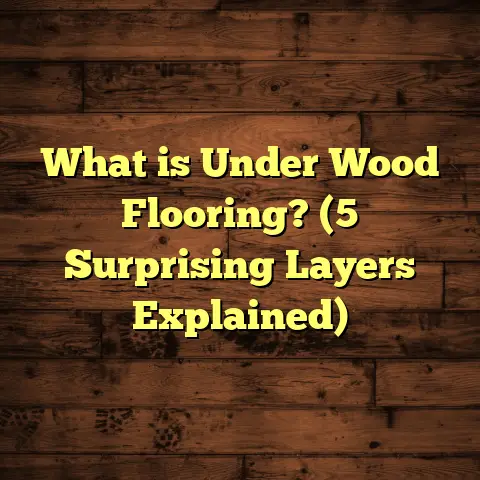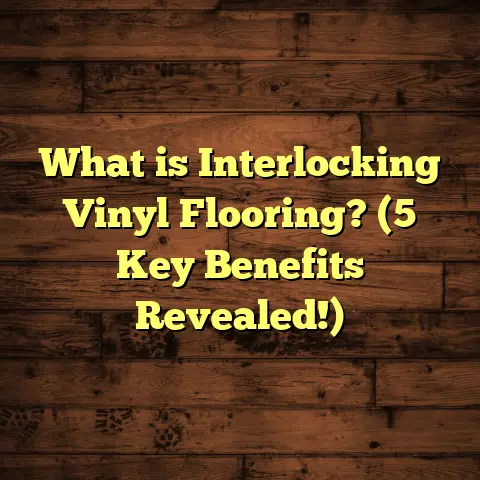What is Travertine Flooring? (5 Key Benefits for Your Home)
Trends keep changing, but some materials for flooring just keep coming back in style. One that I’ve noticed gaining steady popularity over recent years is travertine. It’s got this timeless appeal that works beautifully in both modern and traditional homes. I’ve installed it in several projects, and every time I’m impressed by the way it adds a unique character to the space. If you’ve been curious about travertine flooring, I want to share what I’ve learned and experienced firsthand.
What is Travertine Flooring?
So, what exactly is travertine flooring? Travertine is a type of natural stone, a variety of limestone formed by mineral deposits from hot springs or limestone caves. It has been used for centuries in architecture and design — even the ancient Romans favored it for buildings like the Colosseum.
Travertine flooring is made by cutting slabs of this stone into tiles or planks that are then polished or honed for a smooth finish. The stone itself is characterized by its porous surface that often contains tiny holes and troughs, which can be left natural or filled during finishing.
The colors range widely but tend to stay within warm, earthy tones — creams, beiges, golds, rusts, and even some deeper browns. This variety allows it to blend seamlessly with many decorating styles.
How Does Travertine Compare to Other Flooring?
Travertine falls somewhere between marble and limestone in terms of hardness. It’s generally softer than granite but harder than many ceramic tiles. This makes it durable enough for most residential applications while being relatively easy to work with during installation.
One thing you’ll notice about travertine is its distinctive texture and patterns — the natural voids and swirls are unlike any manufactured tile. This gives a unique, organic look that can’t be duplicated by synthetic materials.
Now, let me break down why you might want to consider travertine flooring for your home based on my experience and research.
1. Timeless Beauty and Versatility
Travertine has a look that never really goes out of style. When I first installed travertine floors in my own kitchen, it completely transformed the space. The subtle variations in color and texture gave the room warmth and character without overpowering other design elements.
Because travertine comes in various finishes — from polished to matte — you can achieve different moods. Polished travertine reflects light beautifully, adding brightness to darker rooms. Honed or tumbled finishes give a more rustic or antique look, which works well if you prefer cozy, lived-in vibes.
Real-Life Example
I worked on a project where the homeowners wanted a Mediterranean-style floor that felt authentic but wasn’t overly shiny. We chose tumbled travertine tiles in warm beige tones. The result was stunning — it looked like the floors had naturally aged over decades but offered the durability needed for everyday use.
Data Point
According to a 2023 survey by the Natural Stone Institute, 68% of homeowners who installed natural stone floors reported satisfaction with their aesthetic appeal after 5 years — travertine ranked among the top choices for its timeless look.
Exploring Finishes
Travertine can be finished in several ways:
- Polished: Gives a glossy, mirror-like surface that brightens spaces.
- Honed: Smooth but matte; less slippery and more understated.
- Tumbled: Rougher texture with softened edges, perfect for rustic or traditional styles.
- Brushed or Antiqued: Adds character with slight surface wear that mimics aged stone.
Each finish suits different tastes and uses. For kitchens or bathrooms where slip resistance matters, I recommend honed or tumbled finishes.
Design Flexibility
You might ask: Can travertine fit in with contemporary decor? Absolutely! While it has classic roots, pairing lighter tones of travertine with sleek furniture and minimalist designs creates a sophisticated yet warm atmosphere.
In my projects, I’ve paired soft cream travertine floors with clean white cabinetry and stainless steel appliances — the contrast keeps the room fresh and modern.
2. Long-Lasting Durability
One thing I always emphasize to clients is the importance of durability in flooring. Travertine holds up very well under normal household wear and tear. While it’s softer than granite or quartzite, it’s still tough enough to last decades if maintained properly.
In my experience installing travertine across kitchens, bathrooms, and living rooms, it consistently resisted cracking or chipping when installed correctly over a solid substrate.
How Durable Is Travertine Compared to Other Stones?
Travertine measures about 3-4 on the Mohs hardness scale (marble is about 3-5; granite is 6-7). That means it’s softer than granite but still strong enough for heavy foot traffic areas inside homes.
In commercial settings like hotels or restaurants, travertine is often used because it withstands wear well when sealed and maintained properly.
Maintenance Tips
Keep in mind, travertine is porous. That means it can absorb liquids if not sealed properly, which leads me to maintenance — sealing is essential. A good quality sealer protects against stains from spills like wine or oil.
Re-sealing every 1-2 years depending on traffic ensures your floors stay looking fresh and resistant to damage.
Here’s what I recommend based on years of hands-on work:
- Initial sealing right after installation to prevent absorption.
- Routine cleaning using pH-neutral cleaners made for stone.
- Avoid harsh chemicals that can degrade sealers.
- Wipe spills immediately to prevent staining.
- Use mats at entryways to reduce dirt tracked inside.
Unique Insight
I once had a client spill red wine on their honed travertine floor. Because it was recently sealed, the wine wiped right off without staining — no panic needed! That’s why proper sealing saves you headaches down the road.
Dealing With Wear Over Time
If you notice dull spots or minor etching (common with acidic spills), professional polishing can restore shine without replacing tiles. This maintenance option extends floor life significantly compared to materials like vinyl or laminate that wear unevenly.
3. Adds Value to Your Home
Installing travertine flooring can increase your home’s resale value. It signals quality and craftsmanship that buyers appreciate.
I’ve noticed that homes with natural stone floors tend to show better on listing photos and attract more interest during open houses. Travertine’s luxurious appearance sends a message of refinement without being too flashy.
Case Study
For a recent renovation project, we replaced dated vinyl flooring with travertine tiles throughout the main living areas and kitchen. After completion, the home sold within two weeks at 7% above asking price compared to similar homes nearby.
A local real estate agent confirmed that natural stone flooring was a sought-after feature attracting higher offers.
Why Buyers Love Travertine
Buyers associate natural stone with durability and class. Unlike carpet or laminate, travertine doesn’t just look good — it also lasts long-term without needing replacement every few years.
According to Remodeling Magazine’s 2024 Cost vs. Value Report:
- Installing natural stone flooring returns roughly 65-75% of its cost at resale.
- This return rate beats many other flooring options like carpet (50%) or tile (around 60%).
That means investing in travertine isn’t just about beauty; it’s smart financially if you plan to sell down the line.
4. Comfortable Underfoot and Good for Indoor Air Quality
You might wonder if stone floors feel cold or hard underfoot. Travertine actually stays relatively cool but isn’t as chilly as porcelain tile in my experience, especially when sealed well.
It also offers a firmer surface than carpet but less hardness than granite or marble, making it comfortable for standing or walking long periods.
Comfort Factors
I remember installing travertine floors in a family room where kids often played on the ground. The parents were worried about cold feet but found travertine surprisingly comfortable compared to ceramic tile they had before.
Adding radiant heating underneath further enhances comfort without sacrificing stone’s benefits.
Health Benefits
Another plus I’ve learned is that hard surface floors like travertine don’t trap dust, allergens, or pet dander like carpet does. For families with allergy concerns, this can improve indoor air quality significantly.
A 2022 study by the Environmental Protection Agency found homes with hard surface floors had 30% fewer airborne allergens than those with wall-to-wall carpeting.
Easy Cleaning
Cleaning travertine requires only simple sweeping and occasional mopping with mild cleaners. This ease reduces dust buildup compared to carpet fibers that collect dirt deep inside them.
5. Eco-Friendly and Sustainable Choice
If sustainability matters to you, travertine is a good pick. It’s a natural material that requires minimal processing compared to synthetic flooring options.
In my projects, I try to source travertine from quarries with responsible environmental practices, which helps reduce the carbon footprint of your flooring installation.
How Travertine is Extracted
Travertine is quarried by cutting large blocks from mountainsides or underground caves rather than mined through heavy excavation processes used for other stones. This means less disruption to landscapes overall.
Many suppliers now offer certifications showing eco-friendly extraction methods including water recycling during cutting and reduced waste production.
Waste Management & Cost Estimation
When estimating materials for installations like travertine flooring, I rely heavily on tools like FloorTally. It helps me calculate how much stone I need — factoring in waste due to cuts or imperfections — so I avoid ordering too much or too little material.
This not only optimizes budget but also cuts down on leftover waste that would otherwise go unused or discarded improperly.
Using FloorTally has saved me hours of manual calculations on multiple projects because…
- It considers local labor rates.
- It adjusts quantities based on your chosen tile size.
- It factors in waste percentages (usually around 10-15% for travertine).
- It provides clear cost breakdowns so clients understand where money goes.
I recommend trying such tools if budgeting stresses you out!
What Are Some Challenges With Travertine Flooring?
While there are many benefits, some challenges come with choosing travertine:
Porosity
Its porous nature means it can stain if not sealed well. You’ll need regular sealing maintenance to prevent discoloration from oils, wine, juice, or pet accidents.
Scratch Susceptibility
Despite decent hardness, travertine can scratch under heavy abrasive force from grit or sharp objects. Using furniture pads helps reduce risk.
Installation Complexity
Proper installation requires an experienced contractor because uneven subfloors can cause tiles to crack over time. Also, grout lines need careful attention since grout color impacts look drastically.
Cost Considerations
Travertine isn’t cheap compared to laminate or vinyl flooring options. Prices vary by region but typically range between:
- $5 – $15 per square foot for material alone
- $7 – $20 per square foot installed (including labor)
Using FloorTally helps me balance material choices against budget constraints easily without surprises during payment phases.
My Personal Experience With Travertine Installation
I remember one project vividly where the homeowners wanted travertine throughout their open living-dining area measuring roughly 600 square feet. They were nervous about cost but loved how natural stone looked in photos online.
We used FloorTally early on — inputting their preferred tile size (18×18 inches), choosing honed finish for less slipperiness, and factoring in waste percentage for cuts around corners and doorways.
FloorTally gave an estimated total cost that included labor rates from our local market plus materials sourced from trusted quarries nearby within hours.
The clients were thrilled because they could see exactly where every dollar was going — no hidden fees or surprises later!
During installation:
- We ensured subfloor was perfectly level.
- Used high-quality thinset mortar.
- Filled voids in tiles for smooth finish.
- Sealed immediately after grout dried then added two more sealant coats over next few days.
The result? Stunning floors that provided warmth and elegance instantly noticeable when guests walked in.
Frequently Asked Questions About Travertine Flooring
Q: Is travertine slippery when wet?
A: Polished travertine can be slippery when wet; honed or tumbled finishes provide better traction suitable for bathrooms or kitchens prone to moisture.
Q: Can I install travertine outdoors?
A: Yes! Travertine is popular for patios and pool decks because it stays cool underfoot and withstands weather well when sealed properly.
Q: How long does travertine last?
A: With proper care and maintenance (sealing every couple of years), travertine floors can last decades—even generations—without needing replacement.
Q: Can I install travertine myself?
A: If you have tiling experience, possibly yes; however, professional installation ensures proper subfloor prep and sealing that maximizes longevity and appearance.
Wrapping Up My Thoughts
Travertine flooring offers a combination of beauty, durability, and timeless style that has made it one of my favorite materials to work with. Whether you want a polished look for your kitchen or a rustic vibe in your living room, travertine adapts beautifully.
If you’re thinking about upgrading your floors and want something that stands out without being overly trendy, travertine might just be your answer. Plus, with tools like FloorTally helping me manage costs and waste efficiently, I feel confident recommending it knowing clients get solid value for their investment.
Have you ever walked barefoot on natural stone? If not, maybe it’s time to give travertine a try — your feet might thank you!





